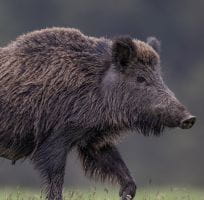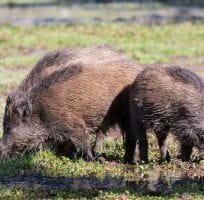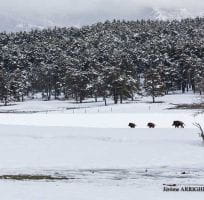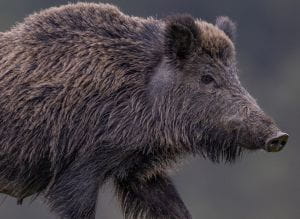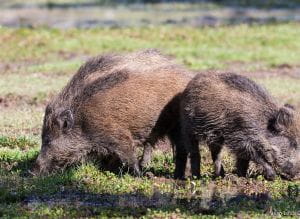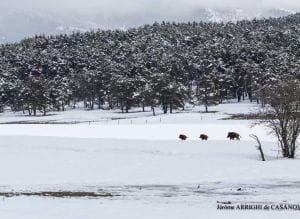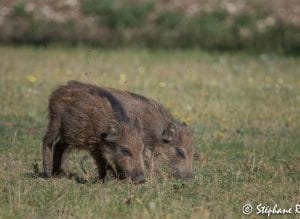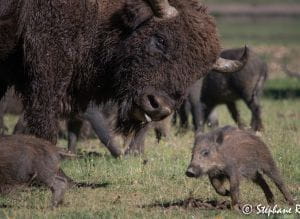A species with a rich vocabulary…
The relationship between man and this species is so ancient and so close, from hunting to domestication, that it has spawned a particularly rich and precise vocabulary.
The males are called “wild boars”, the females “laies”, the young “marcassins”. The marcassins, adorable little striped balls weighing just over 1 Kg at birth, tend to change their coat from the age of 3 months, abandoning the stripes for a uniform reddish coat. They are then called redheads until they acquire their definitive adult coat, which is more gray and black, at around twelve months of age.
In the course of its peregrinations, the wild boar leaves numerous traces in its environment that make it possible to affirm its presence. These include:
– The cauldron: a more or less developed excavation in low vegetation where the laie gives birth (from 2 to 8 young). Gestation lasts 3 months, 3 weeks and 3 days. The number of young seems to be correlated with the female’s weight and health. Nursing lasts 3 to 4 months.
– The bauge: shelter where the animal rests preferably in the most forested and well-exposed areas.
– Leave: adult boar excrement made up of several 5 cm-diameter elements associated with each other, more or less agglomerated.
– The boutis: area of soil turned over as if ploughed, where the animal seeks its food.
– Soil: moist place where the boar rolls to get rid of external parasites.
– The rub: after the soiling, the boar likes to rub against trees (close to the soiling place) on which it leaves traces of mud.
– Housing: a trace or accumulation of dry or fresh mud on various surfaces where the wild boar has come to rub itself after its mud bath. Usually located close to the stain, it can be several hundred meters away from it.
A great many other terms are used depending on the region and local dialect.
And to ancient history…
The wild boar”s range extends from Western Europe to China and Indonesia, via North Africa.
The wild boar has been present in a large part of Europe for thousands of years, in France since the beginning of the Middle Pleistocene (-775,000 to -130,000 years ago)!
Represented in certain caves around the Mediterranean basin, evoked in Greek mythology and depicted in hunting texts from the Middle Ages, it has been living side by side with man for a very long time.
Its presence in the Alpes-Maritimes and in France is well documented.
Its presence in the Alpes-Maritimes and Vaucluse regions has been confirmed by excavations dating back to the Upper Paleolithic, i.e. from 40,000 to 9,500 years ago!
This species seems to have a great affinity for temperate climates, and the wild boar didn’t conquer French territory until the beginning of the Holocene, just over 10,000 years ago. At that time, only wild pigs existed on Earth!
A sawtooth of population dynamics in Europe!
From the 15th to the 17th century, wild boar populations would fluctuate between rare and very abundant, depending on the ecological conditions of the forests. Between the beginning of the 17th and the end of the 18th centuries, farmed wild boar and hybrids of farmed wild boar and domestic pigs were introduced into the national forests to popularize an activity previously reserved for the nobility and royalty: hunting.
These introductions were, despite everything, to be a success.
These introductions were, however, very sporadic and had no significant impact on wild dynamics.
By the middle of the 19th century, populations were on the rise again throughout Europe.
But also in France…where numbers explode
At the end of the 18th century in France, hunting was so popular that wild boar virtually disappeared from French forests. During the 19th century, numbers recovered, but not evenly, as the species was pushed back into forested areas.
The disappearance of predators such as the wolf and lynx in the first half of the 20th century partly explains the growth in its populations, reinforced by the cessation of hunting during World War II.
But the dynamics of wild boar populations in France were to take a decisive turn during the 1960/70 decade, under the effect of multiple anthropogenic factors:
- releases of farmed wild boars and associated hybrids in the 70s,
- increased fertility of adults,
- forest modification, with abundant planting of oak and beech, which attract wild boar more than pine forests,
- reduction of the wild boar’s natural territories and forced sharing of these territories with a hybrid, the cochonglier,
- competition for the same food resources between wild boar and cochonglier,
- disappearance of predators,
- appearance of huge agricultural fields at the edge of forests,
- climate changes leading to milder winters, and therefore less mortality among marcassins,
- disappearance of small game and introduction of wild boar as a replacement.
All these factors have led to a significant increase in the numbers of this species. At the same time, however, wilderness areas have shrunk, as human population growth has led to the need to clear land to build towns or increase agricultural land.
The reduction in wild territories has resulted in the conflict of use that we are experiencing, both in forested areas with the development of forestry and in agricultural areas with damage estimated at 60 million euros in 2022.
The wild boar is one of the world’s most threatened species.
The wild boar is a remarkable, ubiquitous species with very high adaptive capacities. It’s about time mankind took steps to defuse these conflicts and set aside 30% of its territories for the Wild, as in fact provided for in the Montreal Cop 15 agreement (December 2022)!
The wild boar, a formidable gardener
The wild boar’s diet is particularly varied. A true omnivore, it preys equally well on roots, bulbs, fruit and grasses, as well as insect larvae, eggs and sometimes animal corpses.
This practice has earned it the unloved animal of farmers! And yet, wild boars play an essential role in the proper functioning of European forest ecosystems.
The wild boar is the wild gardener of the forest. By turning over the soil with its snout (nose) in search of food, the wild boar ploughs the forest floor.
This mechanical action (plowing) has several consequences favorable to soil dynamics:
- Aeration and oxygenation leading to an increase in soil microbial activity and the production of plant organic matter (biomass).
- Soil permeabilization, favoring deep penetration of rainwater and long-term hydration of vegetation,
- Significant reduction in runoff and soil leaching during heavy rainfall events,
- Dissemination of pollen and seeds attached to hairs during their movements. Thanks to this transport, several dozen plant species can colonize new areas. This phenomenon is known as “epizoochory”.
It’s also a highly sociable animal
The wild boar, with the exception of adult males, is an ungulate that forms social groups, called companies, made up of females, young liver-striped marcassins and redheads over six months old.
These mixed groups are most often led by a leader (oldest female), with males of breeding age tending to leave the companies to become solitary. As in the case of the European bison, magpies in the same company create crèches where the young of the year are raised and protected by adult females who take it in turns to nurse the company’s young.
Breeding takes place in winter, from November to January, although recent studies tend to show that climate change would generate more and more mating episodes at any time of the year.
The males then engage in relatively violent fights to win the females’ favor.
On the Reserve, calving tends to take place in late winter (February-March) after a gestation period of around 17 weeks. The young are born in a “nest”, known as a cauldron, which the mother has carefully fashioned from stubble harvested from the surrounding area.
At the Reserve, calving takes place in late winter.
Very ancient domestication by man
The domestication of the wild boar is thought to have begun around 8500 BC in Turkey, and the pig is thought to have been introduced into France as early as the middle of the 6th millennium BC.
However, the origin of the domestication of the wild boar is not unanimous, and even today, two theories clash:
- All pigs are thought to have originated from the Eurasian wild boar (Sus scrofa), domesticated 9,000 years ago in Asia Minor and the Turkestan region,
- OR they would have 2 different origins: the pigs of Europe, Africa, America and Oceania would come from the domestication of Sus scrofa (- 9,000 years ago) and the pigs of Asia Minor and Southeast Asia from that of the Southeast Asian dwarf boar (Sus vittatus. – 8,000 years ago).
For the record, the domestic pig was introduced to North America by Christopher Columbus on his second voyage in 1493.
